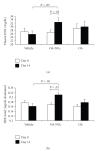Effects of Endogenous PPAR Agonist Nitro-Oleic Acid on Metabolic Syndrome in Obese Zucker Rats
- PMID: 20671947
- PMCID: PMC2910468
- DOI: 10.1155/2010/601562
Effects of Endogenous PPAR Agonist Nitro-Oleic Acid on Metabolic Syndrome in Obese Zucker Rats
Abstract
Nitroalkene derivatives of nitro-oleic acid (OA-NO(2)) are endogenous lipid products with novel signaling properties, particularly the activation of PPARs. The goal of this proposal was to examine the therapeutic potential of this OA-NO(2) in treatment of obesity and obesity-related conditions in obese Zucker rats. The animals were randomly divided to receive OA-NO(2), oleic acid (OA), both at 7.5 mug/kg/d, or vehicle ethanol via osmotic mini-pumps for 2 weeks. Following OA-NO(2) treatment, food intake was decreased as early as the first day and this effect appeared to persist throughout the experimental period. At day 14, body weight gain was significantly reduced by OA-NO(2) treatment. This treatment significantly reduced plasma triglyceride and almost normalized plasma free fatty acid and significantly increased plasma high-density lipid (HDL). The plasma TBARS and proteinuria were paralelly decreased. In contrast, none of these parameters were affected by OA treatment. After 14 days of OA-NO(2) treatment, hematocrit, a surrogate of fluid retention associated with PPARgamma agonists, remained unchanged. Together, these data demonstrated that OA-NO(2) may offer an effective and safe therapeutic intervention for obesity and obesity-related conditions.
Figures









Similar articles
-
Oleoylethanolamide, an endogenous PPAR-alpha agonist, lowers body weight and hyperlipidemia in obese rats.Neuropharmacology. 2005 Jun;48(8):1147-53. doi: 10.1016/j.neuropharm.2005.02.013. Epub 2005 Apr 21. Neuropharmacology. 2005. PMID: 15910890
-
Novel effects of the cannabinoid inverse agonist AM 251 on parameters related to metabolic syndrome in obese Zucker rats.Metabolism. 2013 Nov;62(11):1641-50. doi: 10.1016/j.metabol.2013.06.011. Epub 2013 Aug 6. Metabolism. 2013. PMID: 23932644
-
Nitro-oleic acid protects against endotoxin-induced endotoxemia and multiorgan injury in mice.Am J Physiol Renal Physiol. 2010 Mar;298(3):F754-62. doi: 10.1152/ajprenal.00439.2009. Epub 2009 Dec 23. Am J Physiol Renal Physiol. 2010. PMID: 20032118 Free PMC article.
-
Oxidized and nitrated oleic acid in biological systems: analysis by GC-MS/MS and LC-MS/MS, and biological significance.Biochim Biophys Acta. 2011 Nov;1811(11):694-705. doi: 10.1016/j.bbalip.2011.06.015. Epub 2011 Jun 26. Biochim Biophys Acta. 2011. PMID: 21771665 Review.
-
Novel approach to treat insulin resistance, type 2 diabetes, and the metabolic syndrome: simultaneous activation of PPARalpha, PPARgamma, and PPARdelta.Curr Diabetes Rev. 2005 Aug;1(3):299-307. doi: 10.2174/157339905774574365. Curr Diabetes Rev. 2005. PMID: 18220606 Review.
Cited by
-
New Insights into the PPAR γ Agonists for the Treatment of Diabetic Nephropathy.PPAR Res. 2014;2014:818530. doi: 10.1155/2014/818530. Epub 2014 Jan 29. PPAR Res. 2014. PMID: 24624137 Free PMC article. Review.
-
Protection of nitro-fatty acid against kidney diseases.Am J Physiol Renal Physiol. 2016 Apr 15;310(8):F697-F704. doi: 10.1152/ajprenal.00321.2015. Epub 2015 Dec 30. Am J Physiol Renal Physiol. 2016. PMID: 26719362 Free PMC article. Review.
-
(Pro)renin receptor antagonist PRO20 attenuates nephrectomy-induced nephropathy in rats via inhibition of intrarenal RAS and Wnt/β-catenin signaling.Physiol Rep. 2021 Jun;9(11):e14881. doi: 10.14814/phy2.14881. Physiol Rep. 2021. PMID: 34057312 Free PMC article.
-
Nitro-Fatty Acid Logistics: Formation, Biodistribution, Signaling, and Pharmacology.Trends Endocrinol Metab. 2019 Aug;30(8):505-519. doi: 10.1016/j.tem.2019.04.009. Epub 2019 Jun 10. Trends Endocrinol Metab. 2019. PMID: 31196614 Free PMC article. Review.
-
Profile of Arachidonic Acid-Derived Inflammatory Markers and Its Modulation by Nitro-Oleic Acid in an Inherited Model of Amyotrophic Lateral Sclerosis.Front Mol Neurosci. 2018 Apr 30;11:131. doi: 10.3389/fnmol.2018.00131. eCollection 2018. Front Mol Neurosci. 2018. PMID: 29760648 Free PMC article.
References
-
- Ogden CL, Carroll MD, Curtin LR, McDowell MA, Tabak CJ, Flegal KM. Prevalence of overweight and obesity in the United States, 1999–2004. Journal of the American Medical Association. 2006;295(13):1549–1555. - PubMed
-
- Organization WH. Obesity and overweight facts. July 2004, http://www.who.int/hpr/NPH/docs/gs_obesity.pdf.
-
- Baker PRS, Lin Y, Schopfer FJ, et al. Fatty acid transduction of nitric oxide signaling: multiple nitrated unsaturated fatty acid derivatives exist in human blood and urine and serve as endogenous peroxisome proliferator-activated receptor ligands. Journal of Biological Chemistry. 2005;280(51):42464–42475. - PMC - PubMed
-
- Sachs BA. Appraisal of clofibrate as a hypolipidemic agent. American Heart Journal. 1968;75(5):707–710. - PubMed
Grants and funding
LinkOut - more resources
Full Text Sources
Other Literature Sources

